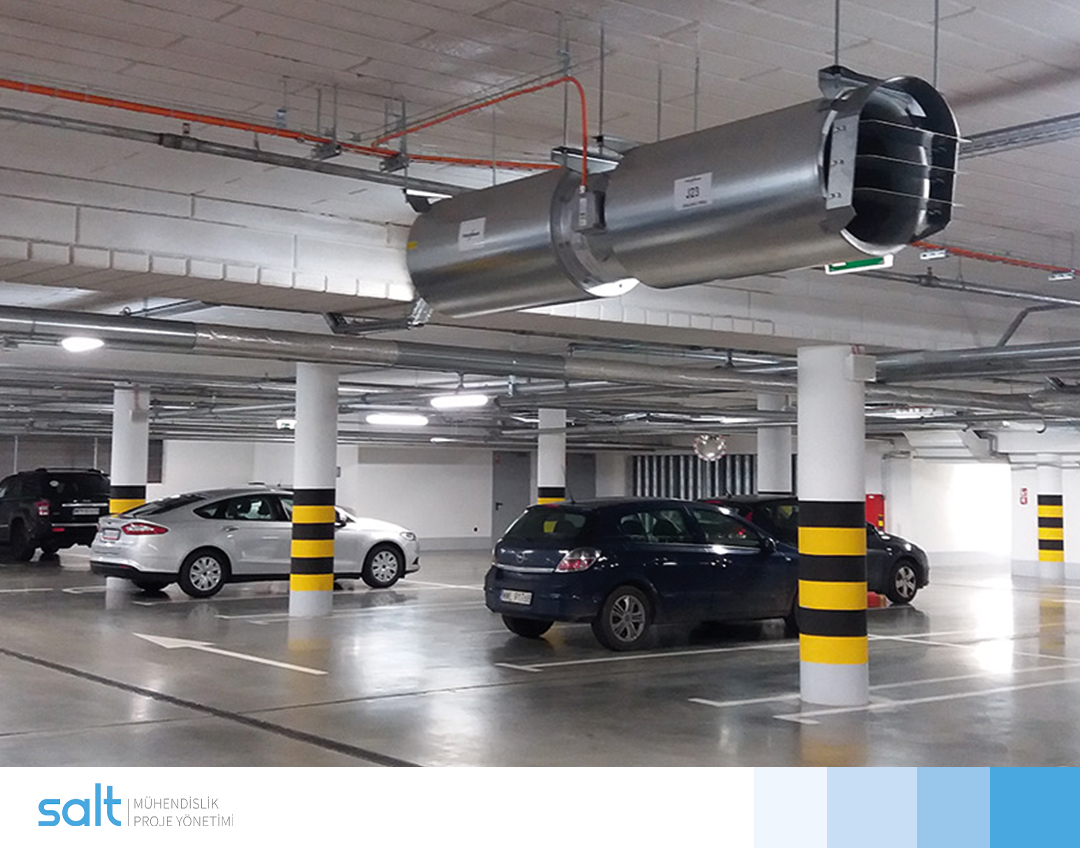
Parking areas in shopping malls are often overlooked. However, a visitor’s first interaction with a mall usually begins in the parking lot. If the air feels suffocating, there is an exhaust odor, or smoke irritates the eyes, it is not just a comfort issue—it poses serious health risks and legal liabilities.
Maintaining air quality and managing exhaust gases in enclosed parking lots is a critical responsibility for visitor safety, employee health, and the sustainable operation of the mall’s technical infrastructure.
How are exhaust gases controlled in mall parking areas? How is air quality measured, and which systems are used for management? Here are the answers in detail:
1. What are the dangers of exhaust gases?
Gasoline and diesel vehicles release numerous harmful gases into the atmosphere when operating:
-
Carbon Monoxide (CO): Colorless, odorless, and deadly poisonous
-
Nitrogen Oxides (NOx): Irritate the respiratory system
-
Hydrocarbons (VOC): Carcinogenic compounds, cause odor
-
Carbon Dioxide (CO₂): Reduces oxygen levels in the environment
Without proper ventilation, these gases accumulate, causing headaches, dizziness, fatigue, and potentially long-term health problems.
2. How is air quality measured in parking lots?
Air quality monitoring systems provide real-time measurements of harmful gases. Common sensors include:
-
CO sensor (carbon monoxide level)
-
CO₂ sensor (indicator of fresh air)
-
VOC sensor (volatile gas accumulation)
-
NOx sensor (presence of nitrogen oxides)
Sensors are installed on walls, ceilings, or columns and transmit data to the building automation system.
Recommended limits (according to OSHA and ASHRAE):
-
CO: below 25 ppm
-
CO₂: below 800–1000 ppm
-
VOC: below 200 ppb
If these limits are exceeded, automatic ventilation systems should activate.
3. Ventilation systems used to manage exhaust gases
-
Zoned (Regional) Exhaust Fans:
-
Used in large parking areas instead of a single fan
-
Receives input from CO or CO₂ sensors
-
Operates only where needed
-
Saves energy and reduces noise
-
-
Fresh Air Supply Fans:
-
Supplies clean air while exhaust gases are removed
-
Improves exhaust efficiency
-
Prevents negative pressure
-
Reduces gas spread
-
-
Jet Fan Systems (Induced Air Ventilation):
-
Used in tunnel-type or large parking lots
-
Directs airflow without ductwork
-
Low installation cost, architectural compatibility
-
Effective over large areas and supports smoke extraction
-
4. Smart Control with Automation
-
Sensor Monitoring: Fan activates when gas levels exceed thresholds
-
Time Scheduling: Automated operation at specific hours
-
Fault Alerts: Notify technical staff in case of fan or sensor failure
-
Energy Optimization: Operates only in needed areas
These systems improve energy efficiency and keep air quality below legal limits.
5. Smoke Extraction and Safety in Case of Fire
Parking systems are critical for smoke removal during fires:
-
Fire-resistant fans (300°C / 400°C)
-
Emergency control based on smoke zones
-
Automatic fire dampers
-
Connected to emergency power
These features remove smoke efficiently from entry and exit routes during fire emergencies.
6. Importance of Regular Maintenance
Even if exhaust and fresh air systems appear operational, lack of maintenance can lead to:
-
Reduced fan efficiency due to dust accumulation
-
Clogged filters
-
Sensor drift (incorrect readings)
-
Accumulated grease and soot in ducts
Recommended maintenance intervals:
-
Fan and motor check: every 3 months
-
Sensor calibration: every 6 months
-
Duct cleaning: annually
-
Filter replacement: every 3–6 months
7. Contribution of Clean Parking Air to the Mall
-
Increases customer satisfaction → “I can breathe easily”
-
Reduces stress while parking → encourages repeat visits
-
Prevents exhaust odors from entering the mall
-
Helps tenants protect products and displays
-
Increases employee efficiency
-
Ensures legal compliance with authorities
Invisible Air Quality, Visible Satisfaction
A mall parking lot is not just a place for vehicles; it’s the first point of contact for customers. The air quality here shapes the perception of the entire building.
With modern sensor-controlled ventilation systems and regular monitoring:
-
Health risks are minimized
-
Energy efficiency is increased
-
Customer loyalty and mall reputation are strengthened
Remember: Toxic gases are invisible, but their effects are lasting.
İlker KURAN
Alperen Mühendislik Ltd. Şti.







